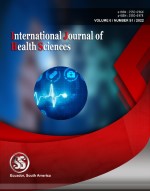Mathematical modeling of ultrashort pulsed laser irradiation in the cornea
Keywords:
temperature, laser, cornea, LTK, laplace transformation technique, hyperbolic modelAbstract
A simple mathematical model for the temperature evolution in the cornea exposed to short-pulsed Ho: YAG laser under Laser Thermo Keratoplasty (LTK) treatment is developed by incorporating the heat flux phase-lag in the Fourier’s heat transfer model and laser source term is described by Lambert Beer’s law. An analytical solution to the mathematical model is obtained using the Laplace transformation technique. The computational results for the temperature profile and the temperature variation with time are presented through the graphs. The effect of some typical parameters: the heat flux phase-lag, convection coefficient and thermal conductivity on the temperature distribution and temperature variations are illustrated and discussed.
Downloads
References
M.A. Mainster (1979) Ophthalmic applications of infrared lasers-thermal considerations. Invest. Ophthalmology Visual Sci. 18 (4): 414– 420
N.A. Peppers et al., (1969) Corneal damage threshold for CO2 laser irradiation. Appl. Opt. 8 (2): 377–381
Z. Zhou et al. (1992) Thermal modeling of laser photothermal keratoplasty (LPTK). in: J.M. Parel (Ed.), Ophthalmic Technologies II, Proceedings of the SPIE, 1644: 61– 71
M.A. Mainster et al. (1970) Corneal thermal response to the CO2 laser. Appl. Opt. 9 (3): 665– 667
R. Brinkmann et al. (1994) Investigations on laser thermo keratoplasty in: S.T. Melamed (Ed.). Laser Applications in Ophthalmology, Proceedings of the SPIE, 2079: 120–130
R. Brinkmann et al. (1996) Corneal collagen denaturation in Laserthermokeratoplasty in: S.L. Jacques (Ed.). Laser-Tissue InteractionVII, Proceedings of the SPIE, 2681: 56–62
R. Brinkmann, N. Koop, K. Kamm, G. Geerling, J. Kampmeier, R. Birngruber, (1996) Laser Thermo keratoplasty by means of a continuously emitting laser diode in the mid-IR, in R. Birngruber, A.F. Fercher, P. Sourdille (Eds.). Lasers in Ophthalmology IV, Proceedings of the SPIE, 2930: 66–74
R. Brinkmann et al. (1997) Laser thermo keratoplasty analysis of in vitro results and refractive changes achieved in a first clinical study in G. Altshuler, R. Birngruber, M.D. Fante, R. Hibst, H. Hoenigsmann, N. Krasner,F. Laffitte (Eds.). Medical Applications of Lasers in Dermatology, Ophthalmology, Dentistry and Endoscopy, Proceedings of the SPIE, 3192: 180–186
R. Brinkmann, B. Radt, C. Flamm, J. Kampmeier, N. Koop, R. Birngruber (2000) Influence of temperature and time on thermally induced forces in corneal collagen and the effect on laser thermo keratoplasty. J. Cataract Refractive Surg. 26 (5): 744–754
F. Manns et al. (2002) Calculation of corneal temperature and shrinkage during laser Thermo keratoplasty (LTK) Ophthalmic Technologies XII, Proceedings of the SPIE,4611: 101–109
A.S. Podol’stev and G.I. Zheltov (2007) Photo destructive effect of IR laser radiation on the Cornea. Geometrical Appl. Opt. 102 (1): 142–146
M. J. Maurer, and H. A. Thompson (1973) Non-Fourier effects at high heat flux. ASME Journal of Heat Transfer”, Series C, 95: 284–286
M. Chester (1963) Second sound in solids Physical Review, 131: 2013–2015
M. Jaunich, S. Raje, K. Kim, K. Mitra, and Z. Guo (2008) Bio-heat transfer analysis during short-pulsed laser irradiation of tissues. Int. J. Heat Mass Transfer 51: 5511- 5521
Amir Mirza Gheitaghy, Behrouz Takabi & Mansour Alizadeh (2014) Modeling of ultrashort pulsed laser irradiation in the cornea based on parabolic and hyperbolic heat equations using an electrical analogy. International Journal of Modern Physics C 25: No.9, 1450039-1-1450039-17
Pennes, H.H. (1948). Analysis of tissue and arterial blood temperature in the resting forearm. J. Appl. Physiol., 1, 93-122
F. K. Storm and D. L. Morton (1983) Localized hyperthermia in the treatment of cancer. CA-Cancer J. Clin. 33: 44
Published
How to Cite
Issue
Section
Copyright (c) 2022 International journal of health sciences

This work is licensed under a Creative Commons Attribution-NonCommercial-NoDerivatives 4.0 International License.
Articles published in the International Journal of Health Sciences (IJHS) are available under Creative Commons Attribution Non-Commercial No Derivatives Licence (CC BY-NC-ND 4.0). Authors retain copyright in their work and grant IJHS right of first publication under CC BY-NC-ND 4.0. Users have the right to read, download, copy, distribute, print, search, or link to the full texts of articles in this journal, and to use them for any other lawful purpose.
Articles published in IJHS can be copied, communicated and shared in their published form for non-commercial purposes provided full attribution is given to the author and the journal. Authors are able to enter into separate, additional contractual arrangements for the non-exclusive distribution of the journal's published version of the work (e.g., post it to an institutional repository or publish it in a book), with an acknowledgment of its initial publication in this journal.
This copyright notice applies to articles published in IJHS volumes 4 onwards. Please read about the copyright notices for previous volumes under Journal History.
















